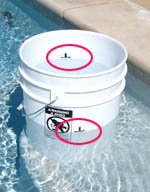Evaporation or Bucket Test

By now we have all heard of the evaporation test, also known as the bucket test. To complete this DIY leak test, the system has to be turned off for at least 24 hours. This test is simply creating two surface areas of water to test the level of the water itself. The steps below completing the test and to properly check water levels:
- Fill the bucket up to 3” from the top
- Set the bucket on the second step if possible, making sure the water level is higher inside the bucket. This helps prevent the bucket from floating in the pool.
- Make a mark both inside and outside the bucket to indicate each water level. Make sure the pump is turned off for the measurement.
- Wait 24 hours to measure the change in water level for both marks.
Note: If each level measures the same amount of change, you do not have a leak. If the difference on the outside of the bucket in the pool is greater than the inside of the bucket then you have a leak. This indicates that your pool has lost more water through leaking than by the natural occurrence of evaporation. It is also a good sign that you need a pool repair service.
Pool Pump On Or Off-Leak Test
If you’re losing more water to the pool turn off or on, this test is simple and easy. Run the pool pump for 12 to 24 hours and turn the pump off for the same amount of time then compare the results of both tests. If you lose more water with the pump running, your pool is leaking in a return line. If there is a greater amount of water loss with the pump off, this indicates a leak in a suction line-skimmer or main drain line. Now if you have water loss both with the pump on and off at the same rate, this indicates a leak in the interior of your pool such as light niche, hole in the liner, and or crack in gunite shell.
Another leak test you can try:
- Start by plugging the pool lines, (making sure the pool pump is turned off) or run off the main by shutting off the skimmer valves at the front of the pump.
- Over the next several days, monitor water levels to check for leaks or evaporation.
This test usually lets us know 90% of the time if leaks are happening in the plumbing or interior.
Note: it is important to monitor the level of water for at least 48 hours after any repair has taken place. If a patch repair was performed the pool should sit still for 12 hours with no swimming and pump turned off. If the level of water is low in the pool, fill it to normal and monitor for a period of 48 hours.
If you have any questions about DIY Leak tests, or would like to schedule an appointment, please feel free to contact us (321) 303-9910.
A professional leak detection service can save you thousands in replacement or foundation repair costs.
